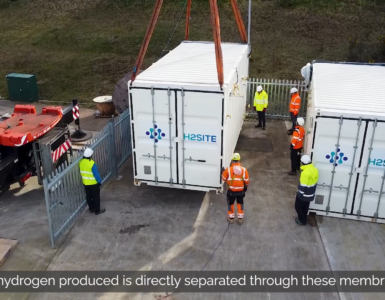The Synergy between Green Hydrogen & Green Ammonia: The Partnership for a Sustainable Green Economy – Stargate Hydrogen.
In the quest for sustainable energy solutions, industries worldwide are turning their gaze towards the potent partnership of green hydrogen and green ammonia. As the spectre of climate change looms ever larger, the transition to cleaner energy sources has never been more pressing. Understanding the intricate dance between these two green powerhouses is paramount for executives leading the charge in glass & ceramics, concrete production, steelmaking, fertilizers, and other heavy industries.
Unlocking Synergies: The Green Ammonia + Green Hydrogen Nexus
While green hydrogen holds immense promise on its own, its synergy with green ammonia unlocks even greater potential. Green ammonia serves as a carrier for hydrogen, offering a means of storing and transporting hydrogen energy efficiently. Companies can circumvent the challenges associated with hydrogen storage and distribution by converting green hydrogen into green ammonia through the Haber-Bosch process.
At its core, green ammonia is synthesized through the sustainable production of hydrogen via electrolysis, powered by renewable energy sources such as wind or solar. This green variant of ammonia stands in contrast to its conventionally produced counterpart, which relies on fossil fuels and emits significant amounts of carbon dioxide.
The Potentials of Green Hydrogen
At the heart of this synergy lies green hydrogen, a clean fuel produced through the electrolysis of water powered by renewable energy sources like wind or solar. Unlike its carbon-intensive counterpart, grey hydrogen, green hydrogen emits zero greenhouse gases during production and combustion, making it a cornerstone of green economy.
The appeal of green hydrogen lies in its versatility. From fueling transportation to storing renewable energy, its applications span far and wide. But where it truly shines is in the industrial realm. Industries grappling with decarbonization, such as glass & ceramics, concrete production, steelmaking, and fertilizers, stand to reap immense benefits from integrating green hydrogen into their operations.
The Role of Green Hydrogen and Ammonia in Industrial Processes
Green ammonia serves as a versatile energy vector, facilitating the integration of renewable hydrogen into existing industrial infrastructure. Its high energy density and ease of handling make it an attractive option for long-term energy storage and transportation. Additionally, green ammonia can serve as a clean fuel for heavy-duty transportation, further reducing reliance on fossil fuels.
Green ammonia’s significance extends beyond its direct applications—it serves as a linchpin for enabling a broader transition to sustainable industrial practices. By acting as a carrier for renewable hydrogen, green ammonia facilitates the efficient storage and transportation of clean energy.
In a nutshell Green hydrogen can be converted to green ammonia to facilitate its transport and storage. When the time comes Green ammonia can again be transformed into Green hydrogen by industries to be used as a potent fuel for powering kilns and furnaces, offering a sustainable alternative to fossil fuels.
Green Ammonia as fuel
Green ammonia can be used as a fuel but with certain considerations and challenges. Ammonia (NH3) is a compound consisting of nitrogen and hydrogen atoms and is commonly used in various industrial applications. As a fuel, ammonia has gained attention due to its potential as a clean energy carrier, particularly for applications where direct electrification or other forms of renewable energy may not be feasible.
Advantages of Ammonia as a Fuel:
- High Energy Density: Ammonia has a high energy density by volume, making it a potentially efficient fuel for transportation and energy storage applications.
- Carbon-Free Combustion: When burned, ammonia produces only water vapor and nitrogen gas, without emitting carbon dioxide (CO2). This makes it attractive for reducing greenhouse gas emissions, particularly in sectors such as shipping and heavy-duty transportation.
- Existing Infrastructure: Ammonia already has a well-established infrastructure for production, distribution, and storage, primarily due to its widespread use in the chemical industry.
Challenges of Using Ammonia as a Fuel:
- Conversion Efficiency: Converting ammonia back into usable energy, whether through combustion in internal combustion engines or through fuel cells, can be less efficient compared to other fuels like hydrogen.
- Safety Concerns: Ammonia is toxic and can be hazardous if mishandled. Safe storage, transportation, and handling procedures are essential for its use as a fuel.
- Emission of Nitrogen Oxides (NOx): While ammonia combustion emits no CO2, it can produce nitrogen oxides (NOx) during combustion, which contributes to air pollution and may require emission control technologies.
- Cost of Production: Green ammonia production methods, such as electrolysis using renewable electricity, may currently be more expensive compared to conventional methods. However, ongoing research and advancements in technology are aimed at reducing production costs.
Industries that directly benefit from the use of Green Ammonia as a Fuel:
Fertilizer production: Ammonia is a key component of nitrogen-based fertilizers, is traditionally produced via the energy-intensive Haber-Bosch process, which relies on fossil fuels. Green ammonia, synthesized using renewable energy-powered electrolysis, offers a sustainable alternative. By integrating green ammonia into fertilizer production, agricultural industries can mitigate emissions and foster sustainable food systems.
Heavy Transportation: Ammonia can be used as a fuel in internal combustion engines, fuel cells, or as a feedstock for hydrogen production It is particularly suitable for long-haul transport modes such as shipping and trucking due to dilution of the costs in large-scale operations.
Power Generation: Ammonia can be burned directly in gas turbines or used in fuel cells to generate electricity, offering a potential avenue for decentralized power generation, especially in areas with limited access to conventional energy sources.
Industries that can benefit indirectly from Green Ammonia:
The industries on the list below can rely on ammonia for the storage and transportation of energy but not directly as fuel. Nevertheless, the benefits exist and can help with the decarbonization of such industries.
Glass & Ceramics:
Glass and ceramics production is notoriously energy-intensive, with traditional furnaces guzzling copious amounts of fossil fuels. By harnessing green hydrogen as a clean heat source, manufacturers can slash carbon emissions while maintaining production efficiency. Moreover, green hydrogen-derived electricity can power kilns and furnaces, offering a dual-pronged approach to decarbonization.
Concrete Production:
The cement industry, a cornerstone of modern infrastructure, is responsible for a significant chunk of global CO2 emissions. Green hydrogen presents a game-changing alternative to the fossil fuels traditionally used in cement kilns. Concrete manufacturers can drastically reduce their carbon footprint without compromising structural integrity by leveraging green ammonia combustion or incorporating green hydrogen into the cement production process.
Steelmaking:
Steel, the backbone of countless industries, is notorious for its carbon-intensive production process. Green hydrogen offers a lifeline to steelmakers grappling with decarbonization mandates. Through direct reduction processes or as a reducing agent in blast furnaces, hydrogen holds the key to unlocking a low-carbon future for the steel industry.
Main Takeaways:
The convergence of green hydrogen and green ammonia stands for an important moment in our journey towards sustainability. Executives across industries are tasked with embracing this responsibility, recognizing the transformative potential inherent in these technologies. Together, green hydrogen and green ammonia form a powerful alliance, paving the way towards a future where sustainability is not just an aspiration but a tangible reality. By harnessing the synergies between these two compounds, industries can unlock unprecedented opportunities for innovation and growth. The journey towards sustainability may be challenging, but with green hydrogen and green ammonia, we can navigate towards a future where economic prosperity and environmental stewardship go hand in hand.
READ the latest news shaping the hydrogen market at Hydrogen Central
The Synergy between Green Hydrogen & Green Ammonia: The Partnership for a Sustainable Green Economy – Stargate Hydrogen. source









